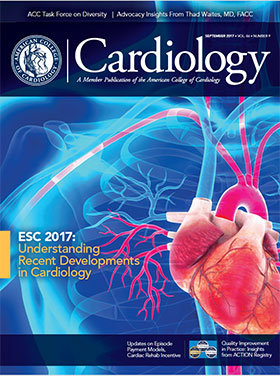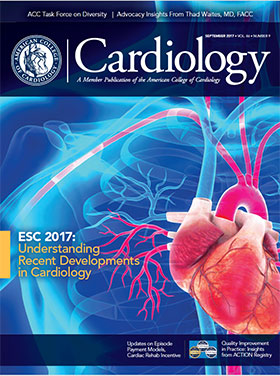Editor's Corner | Highlights From ESC Congress 2017 in Barcelona
A number of meaningful clinical trials that should change practice in the coming year were presented at ESC Congress 2017. An important new concept in cardiac care came from the CANTOS trial examining the effect of the monoclonal antibody canakinumab on cardiovascular events in 10,000 patients with a documented myocardial infarction (MI) and persistently elevated C-reactive protein. After 3.7 years, cardiovascular events were reduced and lung cancer mortality was significantly reduced. The data expand our therapies for chronic coronary disease to use of potent anti-inflammatory drugs.
The debate continues regarding consideration of celecoxib as a substitute for over-the-counter (OTC) NSAIDS. Data from >24,000 patients in a secondary analysis showed no difference in death, MI or stroke at 34 months between celecoxib and NSAIDs. Celecoxib appeared to show some advantages over NSAIDS; despite some safety advantages for celecoxib, many cost-sensitive patients will select lower cost NSAIDs.
Antiplatelet therapy continues to be discussed and this meeting was no exception. Dual antiplatelet therapy (DAPT) after stent implantation was examined in new-generation drug-eluting stents (DES). This trial however leaves us with the continued need for DAPT, albeit possibly of shorter duration vs. previous generation DES. In TROPICAL-ACS, a small improvement in platelet function was noted in patients with evidence of better platelet inhibition, suggesting some value of testing platelet function post acute coronary syndrome (ACS).
Although we’re accustomed to aspirin for secondary prevention, data from COMPASS indicates low-dose rivaroxaban plus aspirin can further lower risk of recurrent cardiovascular events. The advantage of oxygen in ACS remains challenged and DETO2X-AMI did not show an advantage over room air for an acute MI; no difference at one year was seen for all-cause mortality or re-hospitalization.
"There’s much more to discover, yet several take-home messages can be applied now to improve patient care."
The SWEDEHEART registry showed no benefit for bivalirudin over conventional therapy post PCI in 6,006 patients with STEMI and NSTEMI. The Swiss Acute Myocardial Infarction Registry reported a decline in hospital mortality in STEMI patients between 1997 and 2016; from 9.8 to 5.5 percent in men and 18.3 to 6.9 percent in women. This likely reflects better use of evidence-based medicine and incorporating lifestyle changes. Two-year outcome data from FAME 2 support use of fractional flow reserve to evaluate coronary lesions of uncertain significance; false positive and false negative assessment was significantly reduced.
Results from VIVA suggest benefit of adding screening for peripheral arterial disease along with aortic aneurysm and hypertension in patients at risk. With this approach, a significant reduction in mortality from 10.8 to 10.2 percent in 50,156 Danish men ages 65 to 74 was observed.
In HPS3/TIMI 55-REVEAL, anacetrapib provided a small but significant reduction in cardiovascular events (11.8 to 10.8 percent). While data in chronic coronary patients demonstrate small improvements, the cost and need for periodic injections may affect large-scale use. Data from this meeting suggest patients with highest cardiovascular risk should be considered for this therapy.
Atrial fibrillation (AFib) continues to generate new questions regarding detection and therapy. The use of portable monitors was advanced by several studies of episodic, low frequency AFib. An analysis using artificial intelligence methods provided further insight into accuracy and sensitivity of portable monitoring. This type of screening is valuable in lowering the risk of stroke in an asymptomatic population at minimal cost.
Catheter ablation outcomes appear to gain some benefit when using long-term implanted monitors post procedure to manage heart rhythm. REVEAL-AF patients receiving medical therapy and monitoring without ablation had a higher recurrence of AFib at 12 months vs. those who had ablation. Similar findings were seen in patients with left ventricular dysfunction and AFib randomized to conventional therapy or catheter ablation. All had CRT or implanted defibrillator. Longer duration of sinus rhythm was seen after ablation. Death or hospitalization for heart failure occurred in 28.5 percent of ablation group vs. 44.6 percent of control group. The IMPACT trial showed in 2,481 AFib patients an increase in use of anticoagulants from 68 to 79 percent at one year, along with a significant reduction in stroke.
Upstream therapy is the term used to describe a comprehensive approach to patients with AFib and heart failure in the RACE 3 trial, with 72 percent of these patients remaining in sinus rhythm vs. 63 percent of conventional therapy patients.
Ascending aortic replacement appears to have a better outcome when the aortic valve was preserved vs. replaced in the RESPECT or RESECT trial. Candidates for either therapy will require thorough evaluation of comorbidities. Data from the BSCMR Valve Consortium suggest assessment of myocardial scar by cardiac magnetic resonance (CMR) can aid predicting mortality in severe aortic stenosis. While CMR remains costly, often it can refine data on cardiac and valvular function. Data from the SIOVAC trial show sildenafil should be avoided in patients with residual pulmonary hypertension after heart valve surgery; heart failure and hospital admissions were higher in the sildenafil group.
The PURE study that examined the dietary habits of 135,000 subjects suggests that dietary fat may be a better choice than carbohydrates for reducing cardiovascular risk. There’s more evidence that exercise therapy is valuable in improving functional capacity and mortality in heart failure patients with preserved ejection.
Insights and strategies for predicting progressive right heart failure come from reports from several centers showing benefit from echo and hemodynamic measures via implanted left ventricular assist devices. Left atrial appendage closure when added to bypass or valve surgery resulted in a lower rate of stroke, transient ischemic attack or MRI evidence of a silent cerebral infarction vs. no closure (5 vs. 14 percent) over 3.65 years in the LAACS study. In SYNTAX II, a contemporary PCI strategy in three-vessel disease provided a significant reduction at one year in major adverse cardiovascular events (10.6 vs. 17.4 percent in SYNTAX I).
The longstanding use of oxygen in acute MI is again questioned, as is OTC NSAIDS for arthritis. Data from this year’s ESC meeting support many of our ongoing therapies and add important insights into newer therapies for a variety of cardiovascular disorders. Longstanding questions on managing AFib in coronary disease, risk assessment with a non-surgical SYNTAX score and where the new monoclonal antibodies will fit into our therapy for cardiovascular disease gained some insights. There’s much more to discover, yet several take-home messages can be applied now to improve patient care.
Tweet this article: Tweet
Alfred A. Bove, MD, PhD, MACC, is professor emeritus of medicine at Temple University School of Medicine in Philadelphia, and a former president of the ACC.
 |
|
| Click the cover image above to read the latest issue of Cardiology in e-pub format or click here to read it on the web! | |
Keywords: ACC Publications, Cardiology Magazine, Coronary Artery Disease, Myocardial Infarction, Stroke, Neoplasms, Ischemic Attack, Transient, Aspirin, Antithrombins, Atrial Fibrillation, C-Reactive Protein, Anticoagulants, Aortic Valve, Peripheral Arterial Disease, Cardiovascular Diseases, Anti-Inflammatory Agents, Non-Steroidal, Secondary Prevention, Acute Coronary Syndrome, Catheter Ablation, Drug-Eluting Stents, Comorbidity, Heart-Assist Devices, Cicatrix, Myocardial Infarction, Blood Platelets, Risk Factors, Antibodies, Monoclonal, Peptide Fragments, Oxazolidinones, Heart Failure, Stroke, Hypertension, Aortic Aneurysm, Ventricular Dysfunction, Left, Hypertension, Pulmonary, Aortic Valve Stenosis, Magnetic Resonance Spectroscopy, Patient Care, Magnetic Resonance Imaging, Hemodynamics, Arthritis, Life Style, Carbohydrates, Coronary Disease, Cerebral Infarction, Risk Assessment, Defibrillators
< Back to Listings

